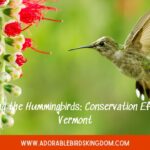I’ve always been fascinated by hummingbirds, those tiny, quick-winged creatures that seem to defy the laws of nature. Imagine my delight when I discovered that Wyoming, with its diverse landscapes and climates, is a hot spot for these incredible birds.
In Wyoming, you’ll find a variety of hummingbird species, each with its unique traits and behaviors. From the broad-tailed hummingbird, known for its high-pitched trill, to the tiny calliope hummingbird, the smallest bird species in North America, Wyoming’s hummingbird population is as diverse as it is captivating.
Whether you’re a birdwatcher, a nature enthusiast, or just someone who appreciates the beauty of the natural world, Wyoming’s hummingbirds are a sight to behold. Let’s take a closer look at these remarkable creatures and their life in the Cowboy State.
Wyoming’s Diverse Hummingbird Species
Wyoming is not just your ordinary state when it comes to hummingbirds. It’s a treasure trove, brimming with diverse species of these feathered wonders. The birds, intrinsically linked to the state’s eco-system, showcase an impressive array of characteristics and behaviors that will leave any nature enthusiast enthralled.
Among the species, the Broad-tailed Hummingbird is a standout. It’s recognized by its keenly plumaged green back and rose-red throat. The males typically make a trilling sound with their wings during courtship displays, further accentuating their presence. Wyoming’s altitude seems to suit them nicely, favoring cold-hardy species like the Broad-tailed.
But Wyoming’s hummingbird repertoire doesn’t stop there. The tiny Calliope Hummingbird, North America’s smallest bird species, also calls Wyoming home. Don’t be fooled by its size; this tiny dynamo is known for its endurance and tenacity. An interesting fact about the Calliope – it’s capable of migrating thousands of miles, much further than larger species.
Yet, there is even more diversity. Let’s look at Rufous Hummingbird, one of the feistiest species with a reddish hue. Their aggressive behavior often leads them to dominate over other species at feeding stations which makes for some interesting observations.
Whether it’s the Broad-tailed’s trilling serenade, the Calliope’s long migrations, or the Rufous’ fiery attitude, Wyoming’s hummingbird species bring a unique blend of characteristics to the table. Each bird, in its own right, adds a dash of color, vigor, and vitality to Wyoming’s vibrant ecosystem.
Wyoming’s rich hummingbird diversity isn’t just appealing to birdwatchers. It’s a spectacle for anyone and everyone with an appreciation for the natural world. So next time you’re in Wyoming, take a moment to observe these fascinating creatures. Who knows—you might just fall in love with the hummingbirds just like I did.
Characteristics of Wyoming’s Hummingbirds
Venturing further into our exploration of Wyoming’s hummingbirds, we delve into their unique characteristics that make each species stand out brilliantly.
Broad-tailed Hummingbirds
Predominantly gracing the American Southwest, the Broad-tailed Hummingbird truly shines amidst Wyoming’s natural landscape. With emerald green back feathers and a rose-red throat, these birds bring a splash of vibrant hues, intrinsically woven into Wyoming’s wildlife.
| Broad-tailed Hummingbird Traits | Description |
|---|---|
| Plumage | Green and rose-red |
| Wingspan | 5.25 inches |
| Weight | 3-4 grams |
Their robust wings, stretching approximately 5.25 inches, showcase a sturdy build, offering more insight into their migratory capabilities. Weighing in at around 3 to 4 grams, their small stature doesn’t do justice to the endurance and strength that these birds muster.
Calliope Hummingbirds
Next, we focus on the Calliope Hummingbird, renowned for being North America’s smallest bird. However, their size, or rather the lack of it, doesn’t hamper their long migratory exploits, evident in their determined flights from Wyoming to Mexico.
| Calliope Hummingbird Traits | Description |
|---|---|
| Size | Smallest in North America |
| Migratory Route | Wyoming to Mexico |
Rufous Hummingbirds
Lastly but far from least, the Rufous Hummingbird sets itself apart with its distinctive aggression. Known for fiercely protecting their territory, these birds epitomize the resilience and tenacity found in Wyoming’s wildlife.
Navigating through the diverse hummingbird species in Wyoming, we start to understand how these tiny creatures mirror the state’s vibrant personality, each bringing unique qualities that echo the versatility and grandeur that Wyoming stands for. Let’s move forward to unveil how they integrate into Wyoming’s ecosystem.
Wyoming Ecosystem and Hummingbird Interaction
Best Locations for Hummingbird Watching in Wyoming
Certainly Wyoming’s natural beauty offers excellent viewing spots for those seeking a glimpse of these fluttering jewels. Let’s delve into a few places you shouldn’t miss on your birdwatching adventure.
Bighorn National Forest teems with life, particularly with Broad-tailed Hummingbirds. Nestled within the rugged mountains, this forest provides an ideal habitat with an abundance of flowers catering to the nectar needs of these little beings. Don’t be surprised if you spot a Calliope Hummingbird, the smallest bird in North America, joining the feast in this vibrant ecosystem.
While in Wyoming, Yellowstone National Park can’t be overlooked. Sprawling across three states, this park is no stranger to the hummingbird fan club. Along its flowing rivers and surrounding wildflowers, catch Rufous Hummingbirds displaying their impressive colors and territorial dominance.
The heart of Wyoming hides a gem, Laramie Peak Wildlife Habitat Management Area. Here, Rufous and Broad-tailed Hummingbirds flutter about in a mesmerizing aerial show. Located in the North Laramie Range, it’s a hummingbird enthusiast’s paradise due to its extensive variety of flowering plants.
Heading over to Seedskadee National Wildlife Refuge, it’s a haven for Calliope Hummingbirds. Its lush marshes and streams provide ample breeding grounds for these pint-sized wonders.
Lastly, witness the flocks at Medicine Bow National Forest. Renowned for its craggy peaks, it’s also home to a variety of hummingbird species all across its vast expanse.
These locations capture Wyoming’s essence, teeming with life and activity. They offer an unparalleled vista to observe these miniature aviators in their natural habitat. It’s not just about viewing the birds – but experiencing the awe they inspire. These are not just stops on a map, they are gateways to unforgettable experiences. So pack your binoculars, put on some comfortable shoes, and immerse yourself in birdwatching bliss.
Conservation Efforts for Hummingbirds in Wyoming
As we delve deeper into our exploration of hummingbirds in Wyoming, it’s important to take notice of the dedicated conservation efforts undertaken to ensure the sustainability of these charming creatures. Hummingbirds, though small in size, play a significant role in pollination and hence, it’s paramount we understand the initiatives ensuring their survival.
Various non-profit organizations, government bodies, state parks, and even individuals in Wyoming have taken up the mantle of hummingbird conservation. The Wyoming Game and Fish Department implements measures to maintain their natural habitats, restricting any activities that could pose a threat.
Additionally, education initiatives such as public workshops and awareness campaigns are in place to inform locals and visitors about the species. The National Audubon Society, for example, runs programs on creating backyard habitats for hummingbirds. I’ve personally attended one of these workshops – the experience was nothing less than enlightening!
In lieu with efforts to protect the hummingbird species, many reserves — Yellowstone National Park and Bighorn National Forest to name a few — further restrict human activities during breeding seasons. This ensures minimal disturbance, letting these avian marvels flourish naturally.
What’s commendable are the citizen-science projects that encourage public participation. Programs such as Project FeederWatch, run by the Cornell Lab of Ornithology, allow you to track and submit data on hummingbirds visiting your feeders. By collaborating, we have the ability to contribute towards meaningful research, helping preserve these magical creatures for future generations.
I would like to encourage all hummingbird enthusiasts out there to join in such initiatives. Everyone has a part to play, whether it’s creating a nurturing environment in your backyard, supporting non-profit organizations, or volunteering towards citizen-science programs.
Remember, the efforts are ongoing. The love and dedication we’ve seen are inspiring, but it’s essential we continue to nurture our Wyoming hummingbird populations. So, let’s understand their needs, respect their habitats and ensure these dazzling creatures continue to grace our beautiful state of Wyoming with their presence.
Do not forget there’s another side to every coin, looking towards the challenges these conservation efforts face. We’ll delve into that in the next section.
Tips for Attracting Hummingbirds to Your Wyoming Garden
Whenever I’m asked about the best ways to attract hummingbirds to a Wyoming garden, my response always revolves around creating a conducive environment and providing essential resources.
First and foremost, plant hummingbird-friendly flora in your garden. Opt for native plants like red columbine, trumpet vine, or beebalm to attract these tiny guests. Why native plants, you may ask? Easy – they’re already adapted to your region’s climate, and local hummingbirds are familiar with them. For maximum attraction, plant these flowers as a cluster to mimic the dense floral sources found in hummingbirds’ natural habitats.
Feeding hummingbirds is another simple yet effective way to attract them to your garden. Invest in a quality hummingbird feeder filled with sugar water that mimics natural nectar. Change the contents every three to four days to ensure freshness. Remember, it’s important to keep your feeder clean to prevent disease transmission among your visiting hummingbirds.
Hummingbirds are not just about flowers and nectar, they also need shelter and protection. Including shrubs and small trees can provide the necessary cover for safety from predators, harsh weather conditions, and also offer potential nesting spots.
Getting involved in conservation efforts could not only enhance your understanding of these birds but also help in attracting them. Participating in initiatives like Project FeederWatch helps you keep track of these wonderful creatures and understand their patterns.
Lastly, always remember not to use pesticides in your garden. Hummingbirds, apart from sipping nectar, also feed on insects. Pesticides can inadvertently harm these small avian wonders.
You don’t have to do everything at once. Start small step by step and eventually you’ll see the buzz of activity in your garden. As time goes on, we’ll share more details on other challenges we often encounter while attracting these tiny birds.
Conclusion
Wyoming’s hummingbird populations are a testament to the state’s rich biodiversity. From the Bighorn National Forest to Yellowstone National Park, these tiny, magical creatures have found a home. And it’s not just about watching these birds in their natural habitat – it’s about preserving them too. I’ve highlighted how organizations and individuals alike are stepping up to protect hummingbirds, ensuring their survival for generations to come. But there’s always room for more help. By creating a hummingbird-friendly garden or joining a citizen-science project, you too can contribute to the conservation efforts. Remember, every little action counts when it comes to protecting Wyoming’s hummingbirds. So, let’s join hands in this noble cause and keep our state buzzing with the delightful presence of these vibrant birds.



